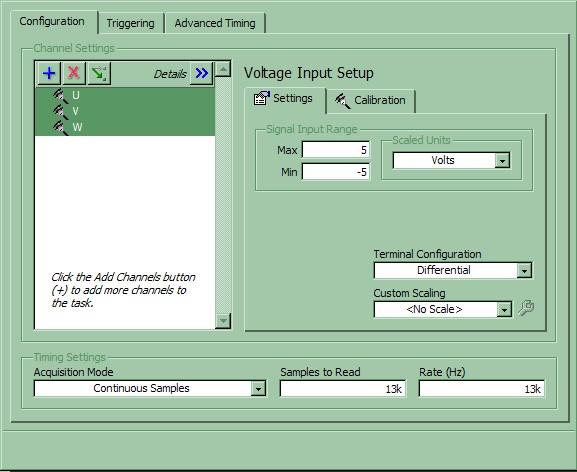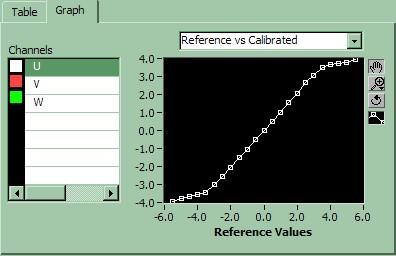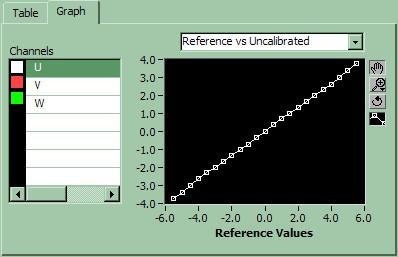
Pollux
Members-
Posts
53 -
Joined
-
Last visited
Profile Information
-
Gender
Male
-
Location
Targoviste, Romania
-
Interests
Electrical Engineering, System control, Bioscience
Contact Methods
- Personal Website
LabVIEW Information
-
Version
LabVIEW 8.0
-
Since
2007
Pollux's Achievements
Newbie (1/14)
0
Reputation
-
Could it be that the information quantity is more than the USB can acquire? I'm not sure if on that computer I have USB 2.0. It's an old laptop from 2004 so it could be that it has only USB 1.1. edit: on second thought it can't be. I also tried a 3 kHz acquisition and it didn't work... I suppose the boards are broken.
-
Hello, Background: I am trying to build an application to monitor the power line of a factory because it is very noisy and we get quite often line stops that affect production. I designed a data acquisition program in Labview using a NI-USB DAQ 6008. It works but the results are not satisfactory since I only have 3kHz per channel (I use 3 channels) so I don't get to see higher frquencies that probably are the reason of our problems. So I switched to NI-USB DAQ 6210. This way I have a 13kHz acquisition rate so I get acces to the 13th harmonic (b.f. 50Hz) and do some oversampling to avoid aliasing. To acquire the signals I use a separation transformer 400V/4V. Problem: I have tested my application in lab, trying to measure a DC voltage of 5.5 Volts and this is what I get: I would have expected to have a continous line since it is a DC voltage that I put on the channels. Repeating the test for other voltages gave similar results. It's like loosing the signal for some fractions of a second. You can see here the configuration of the acquisition task in MAX: I have done the physical connections on the board acording to the indications that MAX gives for Differential measurement. I have also tried to do a calibration. It seems to saturate above 4V as you can see below: It is true that this calibration is done with a standard DC power source that probably has a deviation of tenths of milivolts. I have also tryed with a precision source from Fluke that the Metrology department has but I don't get better results. You can also find a calibration report attached. Supposing that the board is deffective I exchanged it for another of the same type (6210) but I have the same problem. It is also possible that both boards are deffective since I don't know their history before my arrival in the company. What do you think is the problem? Thank you. calib.html
-
Hello guys, I'm back in the LabVIEW business again. I have to do sort of intensity mapping. The only problem is that it has to be represented on a circle. To be more exact: I have a circular surface and I measure 8 points of temperature around. I have to represent a intensity map on a circle in LabVIEW. I saw that LV8.6 has a 3D picture control on which one can map a series of sensors. But since I only need a 2D surface I thought the 3D picture would be to complicated. Any ideas? Thank you
-
QUOTE (hooovahh @ Apr 28 2009, 04:28 PM) It worked. Thank you!
-
I don't know if it is the right area (or forum) to post this but I keep getting the following error when I try to open an .chm file: It says: "Impossible to open the file mk@MSITstore:..." I don't understand where that "mk@MSITstore:" came up. It is the same for every .chm file I try to open. How could I correct this. Any ideas?
-
Calling other VIs to execution
Pollux replied to Pollux's topic in Application Design & Architecture
Hy, I have implemented the queue version and it works fine. New question: what would be a clean method to close my program? I have done this, but it does not work well. If I enable the Exit primitive it halts LV and closes all others LV application. If I disable the Exit primitive it stops the application but does not close it. -
Calling other VIs to execution
Pollux replied to Pollux's topic in Application Design & Architecture
QUOTE (Mark Yedinak @ Apr 6 2009, 09:29 PM) I actually don't mind if the calibration runs at the same time with the data acquisition, since my calibration procedure doesn't access any hardware. It just corrects the data stored in a file previously acquired. If the computer running my software has enough processing power they should run fine in parallel. @Neville D, JustinReina: I will read about queued message handler. edit: the example in the first folder runs under LV8.0. Thank you. -
Calling other VIs to execution
Pollux replied to Pollux's topic in Application Design & Architecture
QUOTE (crossrulz @ Apr 6 2009, 08:17 PM) I have done this and it works nice now. I'm still curios to learn about dynamically processes. QUOTE (JustinReina @ Apr 6 2009, 08:57 PM) @mross: that wasn't nice Like a few other people mentioned, your deal is you want parallel stuff to run ('tasks'). So use your event structure to dispatch these tasks (use multiple loops). Main Concept: Responisve GUI handling should be lightweight (i.e. no event response greater than, say 20ms). Try this concept: Best of Luck. -Justin could you save the VIs in 8.0 version, please? -
Calling other VIs to execution
Pollux replied to Pollux's topic in Application Design & Architecture
QUOTE (Michael Aivaliotis @ Apr 6 2009, 07:23 PM) Done. It works fine now. :worship: QUOTE (Michael Aivaliotis @ Apr 6 2009, 07:23 PM) Using an event structure is fine. The problem is you can't do what you want with the existing design. When LabVIEW is inside an event structure executing your subVI code, it is stuck in there and cannot respond to other user events like button presses. Actually, it queues-up events and executes them upon the next iteration of the while loop. If you want to be able to launch multiple UIs in parallel (provided that your hardware can be accessed in parallel), then you need a different approach. See image: This, in my opinion, should get you to your desired goal faster. The alternative is using dynamic calls to parallel process VIs which might be too much for your level of experience. I have tested your proposal, and found out that this approach works just like the event structure. It stacks the events. Probably the dynamic calls to parallel process is the only way to achieve my goal. Can you recommend some documentation? -
Save the potatoes! Each day are slaughter millions of potatoes around the world. Saving a number of potatoes can stop some catastrophes around the world. For the majority love is only a feedback. Each day the greed of full-cannibal Christians and Muslims and Jews and Buddhists and others exceed the compassion and the love towards the innocent potatoes(they will eat the potatoes).
-
Calling other VIs to execution
Pollux replied to Pollux's topic in Application Design & Architecture
@mrross: I have the basic concept of wiring data. But in the main.vi I don't have any data to transmit to the called subvis. To stop the loop in the main.vi I have a button (Quiter) with an associated event handler. @jcarmody: I'm wondering also if my subvis are really closing. To close the VIs I'm using the same technique (button with event handler) like in the following figure: The vis can be closed from one Stop button. And also from the close botton (x) on the title bar. If I close a called vi from that button apparently it closes only the front panel but keeps running, blocking the main.vi. How should I correct this bug? I have changed all the "Mouse Up" events to "Value change" events in all VIs. (Although I knew the Value Change is the correct event to use, I mistakenly selected Mouse Up for one button and continued with this for the others...) @menghuihantang: I'm using Event structure because a guru o this forum once told me "Event structure is THE WAY to build user interfaces" (sorry I can't remamber his name :worship: ). And besides, it's easyer than using case structure. Vhat I'm really trying to do is a interface in which main.vi is able to call a subvi (take achizitie.vi for example) but at the same time, main.vi should remain active so the user can call another subvi (calibrare.vi for example). (I hope I am clear enough...) Thank you for your advices! -
Hello, I'm doing a project wich will have a front panel with 3 buttons, each of them calling to execution another VI. Like this: (main.vi is calling calibrare.vi and achizitie.vi) main.vi: For some reason after calling one of them, executing and exiting the vi, the main vi doesn't respond anymore to comands. So, what si the best way to call a vi to execution?
-
Very funny, but nothing compares to some refreshing Hertzfeldt humor. [/url]
-
did he actually put his child on fire to make this video?
-
QUOTE (rolfk @ Dec 19 2008, 10:42 PM) I didn't knew that.




